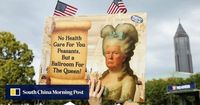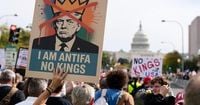On October 18, 2025, a wave of “No Kings” protests swept across the United States, drawing millions of demonstrators into the streets of cities large and small. From New York’s Times Square to the sunlit beaches of San Francisco, Americans of all ages gathered to voice their alarm over what they see as the rapid slide of the government into authoritarianism under President Donald Trump. The day’s events, which spanned more than 2,600 registered rallies, marked the third such mass mobilization since Trump’s return to the White House and unfolded against the tense backdrop of an 18-day government shutdown.
According to the Associated Press, the protests were as much a celebration of civic engagement as a call to action. Marching bands played, demonstrators hoisted banners bearing the U.S. Constitution’s “We The People” preamble, and inflatable frog costumes—now a symbol of resistance in Portland—bounced through the crowds. “Nothing is more patriotic than protesting” and “Resist Fascism” were among the slogans emblazoned on homemade signs, as thousands filled parks in Boston, Atlanta, and Chicago, marched through Washington and Los Angeles, and picketed outside capitols in several Republican-led states.
“It just feels like we’re living in an America that I don’t recognize,” said Jessica Yother, a mother of four who joined more than 1,500 others in Birmingham, Alabama—a city with deep roots in the Civil Rights Movement. “It was so encouraging. I walked in and thought, ‘Here are my people.’” Her sentiment echoed across the country, as parents with strollers, retirees, and even pets joined the festivities.
In Portland, Oregon, tens of thousands gathered for a peaceful demonstration downtown. Later, tensions flared near a U.S. Immigration and Customs Enforcement building, where federal agents deployed tear gas to disperse a crowd and city police threatened arrests if streets were blocked. According to the Associated Press, the building has been the site of nightly protests since June—one of the reasons the Trump administration cited for attempting to deploy National Guard troops in the city, a move temporarily blocked by a federal judge.
Hayley Wingard, dressed as the Statue of Liberty on Ocean Beach in San Francisco, told AP reporters, “I was actually OK with everything until I found that the military invasion in Los Angeles and Chicago and Portland—Portland bothered me the most, because I'm from Portland, and I don't want the military in my cities. That's scary.” Hundreds of others joined her to spell out “No King!” with their bodies in the sand, a striking visual rebuke to the president’s approach.
In Washington, Iraq War Marine veteran Shawn Howard explained why he attended his first-ever protest: “I fought for freedom and against this kind of extremism abroad,” he said. “And now I see a moment in America where we have extremists everywhere who are, in my opinion, pushing us to some kind of civil conflict.” Howard, who also served two decades at the CIA on counter-extremism, cited immigration detentions without due process and the deployment of troops in U.S. cities as “un-American” and alarming signs of eroding democracy.
The “No Kings” movement, according to CTV News and SBS, was organized by more than 300 grassroots groups, with the American Civil Liberties Union providing legal and de-escalation training to tens of thousands of volunteer marshals. The protests drew support from a broad swath of the political left, including Senator Bernie Sanders, Representative Alexandria Ocasio-Cortez, and former Secretary of State Hillary Clinton. Senate Minority Leader Chuck Schumer declared on X (formerly Twitter), “Today's No Kings rallies are an affirmation of what America is all about. We are a democracy.” House Minority Leader Hakeem Jeffries added, “Peaceful protest against an out-of-control President is the American way.”
Leah Greenberg, co-founder of the progressive organizing group Indivisible, told SBS, “There is nothing more American than saying, 'We don't have kings' and exercising our right to peacefully protest.” She emphasized that the rallies were meant to unite a divided opposition and embolden officials at every level to resist what organizers view as Trump’s overreach.
Not everyone agreed. Republican leaders, including House Speaker Mike Johnson, disparaged the demonstrations as “Hate America” rallies and blamed them for prolonging the government shutdown. “I encourage you to watch—we call it the Hate America rally—that will happen Saturday,” Johnson said, listing “antifa types,” people who “hate capitalism,” and “Marxists in full display” among the expected participants. The Trump campaign, for its part, mocked the protests by posting a computer-generated video of the president dressed as a monarch, complete with crown and balcony wave.
President Trump, meanwhile, spent the weekend at his Mar-a-Lago home in Florida. In a Fox News interview aired the day before the protests, he addressed the accusations head-on: “They say they’re referring to me as a king. I’m not a king.” The president’s denials did little to quell the anger and anxiety among demonstrators, who cited criminal prosecutions of Trump’s perceived political enemies, a militarized immigration crackdown, and the installation of loyalists throughout the administration as evidence of democratic backsliding.
Despite the charged rhetoric, the events remained largely peaceful and festive. Police kept a low profile, and in New York City, authorities reported no arrests. In Salt Lake City, about 3,500 gathered outside the Utah State Capitol to share messages of hope and healing, just months after a protester was fatally shot during the city’s first “No Kings” march in June. Across the country, the day was marked by a sense of camaraderie and defiance—marchers dressed in costumes, waving U.S. flags, and carrying balloons, with some even donning prison stripes and caricature masks of Trump and his officials.
As the government shutdown dragged on, Democrats refused to vote on legislation that would reopen federal agencies unless Republicans agreed to fund health care initiatives. Republicans insisted that such discussions could only happen after the government was back up and running. The standoff has tested the balance of power between the executive, Congress, and the courts, with the “No Kings” protests symbolizing a broader struggle over the direction of American democracy.
For many, the day’s rallies were about more than just opposition to Trump—they were a reaffirmation of American values and a reminder that, as Bernie Sanders told the Washington crowd, “We the people will rule.” The “No Kings” movement, with its blend of street-party exuberance and urgent political messaging, has helped galvanize a diverse coalition determined to defend the nation’s democratic institutions, even as the path forward remains uncertain.

